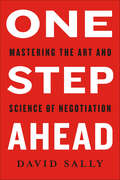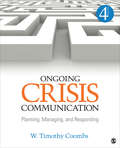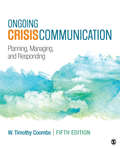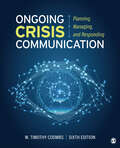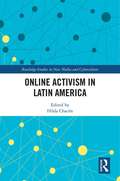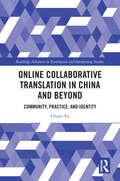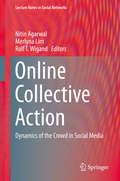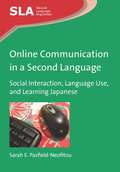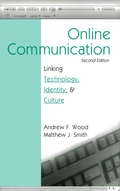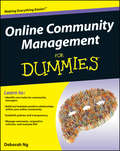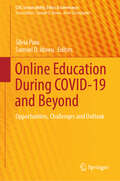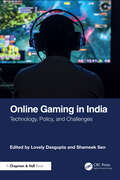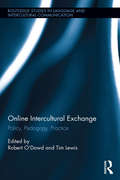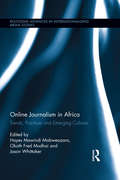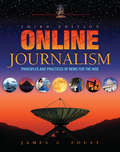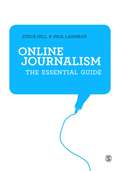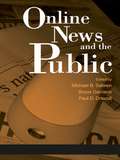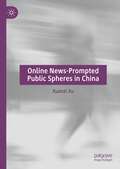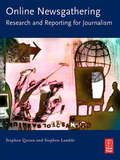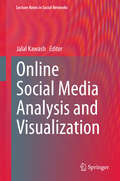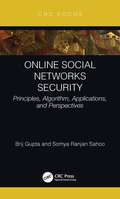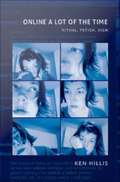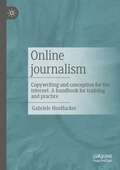- Table View
- List View
One Step Ahead: Mastering the Art and Science of Negotiation
by David SallyThere’s been a revolution in negotiating tactics.The world’s best negotiators have moved beyond How to Win Friends & Influence People and Getting to Yes. For over twenty years. David Sally has been teaching the art of negotiation at leading business schools and to executives at top companies. Now, he delivers the proven, clear, actionable insights you need to stay competitive in an ever-changing marketplace.One Step Ahead offers the fundamental wisdom that elevates the sophisticated negotiator above everyone else. Readers will gain the advantage in everything from determining when to negotiate and deciphering a game strategically, to understanding which personality traits matter, why emotions are not necessarily to be avoided, and how to be tough and fair. You’ll learn to be round on the outside and square on the inside, how to command the idiom, why to avoid bumping into the furniture, and how to achieve mastery of the word and the number. While all of life is not a negotiation, Sally says, a negotiation incorporates all of life—One Step Ahead is for anyone and everyone who bargains, parents, manages, buys, sells, emotes, and engages.Based on cutting-edge studies and real-world results, and drawing parallels to everything from the NBA to the corner con game to Machiavelli, Xi Jinping, and Barack Obama, One Step Ahead upends conventional wisdom to make sure that you have what it takes to stay one step ahead—no matter whom you are facing across the table.
Ongoing Crisis Communication: Planning, Managing, and Responding
by Timothy CoombsOngoing Crisis Communication: Planning, Managing, and Responding provides an integrated and multi-disciplinary approach to the entire crisis communication process. Drawing on his extensive firsthand experience, Dr. Timothy Coombs uses a three-staged approach to crisis management (pre-crisis, crisis, and post-crisis), explains how crisis management can prevent or reduce the threats of a crisis, and provides guidelines for how best to act and react in an emergency situation. The book includes new coverage of social media, social networking sites, and terrorist threats while drawing from recent works in management, public relations, organizational psychology, marketing, organizational communication, and computer-mediated communication research.
Ongoing Crisis Communication: Planning, Managing, and Responding
by Timothy CoombsOngoing Crisis Communication: Planning, Managing, and Responding provides an integrated approach to crisis communication that spans the entire crisis management process and crosses various disciplines. A truly integrative and comprehensive text, this book explains how crisis management can prevent or reduce the threats of a crisis, providing guidelines for how best to act and react in an emergency situation. The Fifth Edition includes new coverage of social media, social networking sites, and terrorist threats and includes expanded discussions of internal crisis communication and intuition in decision making.
Ongoing Crisis Communication: Planning, Managing, and Responding
by Timothy CoombsOngoing Crisis Communication: Planning, Managing, and Responding provides an integrated approach to crisis communication that spans the entire crisis management process and crosses various disciplines. A truly integrative and comprehensive text, this book explains how crisis management can prevent or reduce the threats of a crisis, providing guidelines for how best to act and react in an emergency situation. The Fifth Edition includes new coverage of social media, social networking sites, and terrorist threats and includes expanded discussions of internal crisis communication and intuition in decision making.
Ongoing Crisis Communication: Planning, Managing, and Responding
by Timothy CoombsOngoing Crisis Communication: Planning, Managing, and Responding provides an integrated approach to crisis communication that spans the entire crisis management process and crosses various disciplines. A truly integrative and comprehensive text, this book explains how crisis management can prevent or reduce the threats of a crisis, providing guidelines for how best to act and react in an emergency situation. The Sixth Edition includes new coverage of artificial intelligence and risk management, social media, resilience training for the community, and draws upon recent work from management, public relations, organizational psychology, marketing, organizational communication, and computer-mediated communication research.
Ongoing Crisis Communication: Planning, Managing, and Responding
by Timothy CoombsOngoing Crisis Communication: Planning, Managing, and Responding provides an integrated approach to crisis communication that spans the entire crisis management process and crosses various disciplines. A truly integrative and comprehensive text, this book explains how crisis management can prevent or reduce the threats of a crisis, providing guidelines for how best to act and react in an emergency situation. The Sixth Edition includes new coverage of artificial intelligence and risk management, social media, resilience training for the community, and draws upon recent work from management, public relations, organizational psychology, marketing, organizational communication, and computer-mediated communication research.
Online Activism in Latin America (Routledge Studies in New Media and Cyberculture)
by Hilda ChacónOnline Activism in Latin America examines the innovative ways in which Latin American citizens, and Latin@s in the U.S., use the Internet to advocate for causes that they consider just. The contributions to the volume analyze citizen-launched websites, interactive platforms, postings, and group initiatives that support a wide variety of causes, ranging from human rights to disability issues, indigenous groups’ struggles, environmental protection, art, poetry and activism, migrancy, and citizen participation in electoral and political processes. This collection bears witness to the early stages of a very unique and groundbreaking form of civil activism culture now growing in Latin America.
Online Collaborative Translation in China and Beyond: Community, Practice, and Identity (Routledge Advances in Translation and Interpreting Studies)
by Chuan YuIn this original and innovative work, Yu boldly tackles the increasingly influential collaborative translation phenomenon, with special reference to China. She employs the unique perspective of an ethnographer to explore how citizen translators work together as they select, translate, edit and polish translations. Her area of particular interest is the burgeoning yet notably distinctive world of the Chinese internet, where the digital media ecology is with Chinese characteristics. Through her longitudinal digital ethnographic fieldwork in Yeeyan, Cenci and other online translation platforms where the source materials usually come from outside China, Yu draws out lessons for the various actors in the collaborative translation space, focusing on their communities, working practices and identities, for nothing is quite as it seems. She also theorises relationships between the actors, their work and their places of work, offering us a rich and insightful perspective into the often-hidden world of collaborative translation in China. The contribution of Yu’s work also lies in her effort in looking beyond China, providing us with a landscape of collaborative translation in practice, in training, and in theory across geographic contexts. This volume will be of particular interest to scholars and postgraduate students in translation studies and digital media.
Online Collective Action
by Nitin Agarwal Merlyna Lim Rolf T. WigandThis work addresses the gap in the current collective action literature exposed by the new Information and Communication Technologies (ICTs) landscape by bringing together qualitative and quantitative studies from computational and social sciences. The book offers a rigorous and systematic investigation of both methodological and theoretical underpinnings and, thus, collectively promotes a symbiotic and synergistic advancement of the multiple interconnected disciplines in studying online collective actions. More specifically, the book is intended to illuminate several fundamental and powerful yet theoretically undeveloped and largely unexplored aspects of collective action in the participatory media (e. g. , social media). Through in-depth exploration of relevant concepts, theories, methodologies, applications, and case studies, the reader will gain an advanced understanding of collective action with the advent of the new generation of ICTs enabled by social media and the Internet. The developed theories will be valuable and comprehensive references for those interested in examining the role of ICTs not only in collective action but also in decision and policy making, understanding the dynamics of interaction, collaboration, cooperation, communication, as well as information flow and propagation, and social network research for years to come. Further, the book also serves as an extensive repository of data sets and tools that can be used by researchers leading to a deeper and more fundamental understanding of the dynamics of the crowd in online collective actions.
Online Communication in a Second Language
by Sarah E. Pasfield-NeofitouOnline Communication in a Second Language examines the use of social computer mediated communication (CMC) with speakers of Japanese via longitudinal case studies of up to four years. Through the analysis of over 2000 blogs, emails, videos, messages, games, and websites, in addition to interviews with learners and their online contacts, the book explores language use and acquisition via contextual resources, repair, and peer feedback. The book provides insight into relationships online, and the influence of perceived 'ownership' of online spaces by specific cultural or linguistic groups. It not only increases our understanding of online interaction in a second language, but CMC in general. Based on empirical evidence, the study challenges traditional categorisations of CMC mediums, and provides important insights relating to turn-taking, code-switching, and language management online.
Online Communication: Linking Technology, Identity, & Culture (Routledge Communication Series)
by Matthew J. Smith Andrew F. WoodOnline Communication provides an introduction to both the technologies of the Internet Age and their social implications. This innovative and timely textbook brings together current work in communication, political science, philosophy, popular culture, history, economics, and the humanities to present an examination of the theoretical and critical issues in the study of computer-mediated communication. Continuing the model of the best-selling first edition, authors Andrew F. Wood and Matthew J. Smith introduce computer-mediated communication (CMC) as a subject of academic research as well as a lens through which to examine contemporary trends in society. This second edition of Online Communication covers online identity, mediated relationships, virtual communities, electronic commerce, the digital divide, spaces of resistance, and other topics related to CMC. The text also examines how the Internet has affected contemporary culture and presents the critiques being made to those changes. Special features of the text include:*Hyperlinks--presenting greater detail on topics from the chapter*Ethical Ethical Inquiry--posing questions on the nature of human communication and conduct online*Online Communication and the Law--examining the legal ramifications of CMC issues Advanced undergraduates, graduate students, and researchers interested in the field of computer-mediated communication, as well as those studying issues of technology and culture, will find Online Communication to be an insightful resource for studying the role of technology and mediated communication in today's society.
Online Community Management For Dummies
by Deborah NgLearn to manage, grow, and communicate with your online community Online community management is a growing profession and companies are investing in online communities in order to gain consumer insights into products and to test new products. An effective and dedicated community manager is essential to engage and manage a successful online consumer community. This straightforward-but-fun guide shows you how to effectively manage, grow, and communicate with your online community. Clear coverage shares tips for dealing with customers and fans through Twitter, Facebook, forums, and blogs. A practical approach shows you how to ensure that visitors to your site are satisfied, kept happy, and return. You'll explore the various types of online communities and benefit from learning an assortment of tips and tools that will help you stand out above the competition, attract more visitors and gain the attention of potential advertisers and investors. Aims at providing community managers the information they need to get a handle on their online communities and make them successful Addresses the role of the community manager, the core community management tasks, and how to create an online community Highlights ways to build relationships within your community, evaluate return on investment, and handle and respond to criticism Offers advice for establishing policies and transparency and encouraging community interaction Online Community Management For Dummies is the ideal introductory guide for making sure that visitors to your site have a good experience and return for more.
Online Education During COVID-19 and Beyond: Opportunities, Challenges and Outlook (CSR, Sustainability, Ethics & Governance)
by Samuel O. Idowu Silvia PuiuThis book aims to provide sustainable solutions for better understanding and management of online education in different parts of the world. In this context, it explores the attitudes and perceptions of stakeholders, such as students, faculty, and other actors on issues related to online education. In particular, it examines the challenges they have faced over the years when online courses were introduced due to the COVID-19 pandemic. A model is proposed that includes five variables: specific communication issues in online education, the ability of professors to offer online courses, the quality of online education, students' perceived stress during online education, and the technical requirements of online education.The book will be of interest to anyone concerned with the new and future ways of teaching and learning.Chapter “When a Phenomenon-Based University Course Went Online: Students’ Experiences and Reflections After Sauna Bathing” is available open access under a Creative Commons Attribution 4.0 International License via link.springer.com.
Online Gaming in India: Technology, Policy, and Challenges
by Lovely Dasgupta Shameek SenThis book offers a comprehensive overview from diverse perspectives of online gaming technology, policy, and experiments to understand and review the Indian approach. It starts with the technological viewpoint on the governance and regulation of online gaming and includes the Indian experiment in governing and regulating it. The book brings a nuanced approach related to the perspectives of various stakeholders, the players, the developers, the gamers, the regulators, the law enforcement agencies, the industry and most importantly, the consumers, who are also the intended audience of the work. Present a holistic view of the online gaming industry from technical, legal and policymaking perspectives Offers critical technical highlights include Online transactions, online games ecosystem, online games varied platforms, web3, metaverse, AI and Fantasy Games Includes a comparative analysis to evaluate better the laws, rules, and regulations and the governance of online gaming in India Encapsulates the Indian experience in intervening and streamlining the online gaming industry The book is for Professionals and scholars in the fields of Online Gaming in computer science, Law, and other related discipline. It also serves as a textbook for students for Online Gaming courses.
Online Intercultural Exchange: Policy, Pedagogy, Practice (Routledge Studies in Language and Intercultural Communication #15)
by Tim Lewis Robert O'DowdThis volume provides a state of the art overview of Online Intercultural Exchange (OIE) in university education and demonstrates how educators can use OIE to address current challenges in university contexts such as internationalisation, virtual mobility and intercultural foreign language education. Since the 1990s, educators have been using virtual interaction to bring their classes into contact with geographically distant partner classes to create opportunities for authentic communication, meaningful collaboration and first-hand experience of working and learning with partners from other cultural backgrounds. Online exchange projects of this nature can contribute to the development of learner autonomy, linguistic accuracy, intercultural awareness, intercultural skills and electronic literacies. Online Intercultural Exchange has now reached a stage where it is moving beyond individual classroom initiatives and is assuming a role as a major tool for internationalization, intercultural development and virtual mobility in universities around the globe. This volume reports qualitative and quantitative findings on the impact of OIE on universities in Europe and elsewhere and offers comprehensive guidance on using OIE at both pedagogical and technological levels. It provides theoretically-informed accounts of Online Intercultural Exchanges which will relevant to researchers in Computer Assisted Language Learning, Computer-Mediated Communication, or Virtual Education. Finally, contributors offer a collection of practitioner-authored and practically-oriented case studies for the benefit of teachers of foreign languages or in other subject areas who wish to engage in developing the digital literacy and intercultural competences of their learners.
Online Journalism in Africa: Trends, Practices and Emerging Cultures (Routledge Advances in Internationalizing Media Studies #12)
by Jason Whittaker Hayes Mawindi Mabweazara Okoth Fred MudhaiVery little is known about how African journalists are forging "new" ways to practise their profession on the web. Against this backdrop, this volume provides contextually rooted discussions of trends, practices, and emerging cultures of web-based journalism(s) across the continent, offering a comprehensive research tool that can both stand the test of time as well as offer researchers (particularly those in the economically developed Global North) models for cross-cultural comparative research. The essays here deploy either a wide range of evidence or adopt a case-study approach to engage with contemporary developments in African online journalism. This book thus makes up for the gap in cross-cultural studies that seek to understand online journalism in all its complexities.
Online Journalism: Principles and Practices of News for the Web
by Jim FoustThe third edition of Online Journalism builds on the foundations of journalism to clearly show how they can be integrated into online environments. It takes the perspective that web content shouldn't be a separate component or an afterthought but instead is a vital part of story creation. From doing research to creating the web space, to posting and getting stories into the hands of users, this useful resource gives students the tools they need. Online Journalism readies readers for wherever their news careers take them, whether it's to the online portion of legacy news organizations, to online-only startups, or to blogs, news apps and beyond. Key features include a companion website, practical activities at the end of each chapter, screenshots illustrating key concepts and a Glossary.
Online Journalism: The Essential Guide
by Steve Hill Paul Lashmar"An essential guide for anyone hungry to learn how journalism should be practised today, and will be tomorrow. Hill and Lashmar encapsulate the transformative impact technology is having on journalism, but anchor those changes in the basic principles of reporting." - Paul Lewis, The Guardian "As the news business transforms, Online Journalism is a fantastic new resource for both students and lecturers. Informative, straightforward and easily digested, it’s a one-stop shop for the skills, knowledge, principles and mindset required for journalistic success in the digital age." - Mary Braid, Kingston University Online and social media have become indispensible tools for journalists, but you still have to know how to find and tell a great story. To be a journalist today, you must have not only the practical skills to work with new technologies, but also the understanding of how and why journalism has changed. Combining theory and practice, Online Journalism: The Essential Guide will take you through the classic skills of investigating, writing and reporting as you master the new environments of mobile, on-demand, social, participatory and entrepreneurial journalism. You will also develop must-have skills in app development for smartphones and tablets, as well as techniques in podcast, blog and news website production. What this book does for you: Tips and advice from leading industry experts in their own words QR codes throughout the book to take you straight to multimedia links A fully up-to-date companion website loaded with teaching resources, detailed careers advice and industry insights Exercises to help you hone your skills Top five guided reading list for each topic, so you can take it further Perfect for students throughout a journalism course, this is your essential guide!
Online News and the Public (Routledge Communication Series)
by Bruce Garrison Michael B. Salwen Paul D. DriscollThis volume offers unique and timely insights on the state of online news, exploring the issues surrounding this convergence of print and electronic platforms, and the public's response to it. It provides an overview of online newspapers, including current trends and legal issues and covering issues of credibility and perceptions by online news users.The heart of the book is formed by empirical studies-mostly social surveys-coming out of the media effects and uses traditions. The chapters are grounded in theoretical frameworks and bring much-needed theory to the study of online news. The frameworks guiding these studies include media credibility, the third-person effect, media displacement, and uses and gratifications. The book ends with a section devoted to research on online news postings.This book is appropriate for scholars, researchers, and students in journalism, mass communication, new media, and related areas, and will be of interest to anyone examining how people use the web as a source for news.
Online News-Prompted Public Spheres in China
by Xuanzi XuThis book argues that there are constant formations of online public spheres in present-day China, prompted by never-ending news. It contends that these publics are chronic, although individually they are usually transient. They are networked, which enables them to go viral in hours, and they may engender unexpected consequences. These features explain why online public spheres survive in China even though censorship and information manipulation are pervasively and strategically maneuvered to guide or manufacture “public opinion”. The book also proposes that there are deeply entangled structural factors bolstering China's online news-prompted public spheres: the continuous flow of news information, the countless public spaces facilitated by China’s digital infrastructure and the rise of rights-conscious netizens. Pushing forward a new way of conceptualizing the idea of public spheres, this book contends clearly that public spheres are most often sparked by chronic news in today's media-saturated societies. Delving into the life cycles of public spheres, it goes beyond static analysis of individual public spheres and instead studies their five qualities, which, except for the networked quality, have never been systematically addressed in scholarship.
Online Newsgathering: Research and Reporting for Journalism
by Stephen Quinn Stephen LambleJournalists used to rely on their notepad and pen. Today, professional journalists rely on the computer-and not just for the writing. Much, if not all, of a journalist's research happens on a computer. If you are journalist of any kind, you need to know how to find the information you need online. This book will show you how to find declassified governmental files, statistics of all kinds, simple and complex search engines for small and large data gathering, and directories of subject experts. This book is for the many journalists around the world who didn't attend a formal journalism school before going to work, those journalists who were educated before online research became mainstream, and for any student studying journalism today. It will teach you how to use the Internet wisely, efficiently and comprehensively so that you will always have your facts straight and fast.Online Newsgathering:. reflects the most current thinking. is pertinent to both industry and education. focuses on what people need to knowPlease visit the authors' companion website at http://computerassistedreporting.com for additional resources.
Online Social Media Analysis and Visualization
by Jalal KawashThis edited volume addresses the vast challenges of adapting Online Social Media (OSM) to developing research methods and applications. The topics cover generating realistic social network topologies, awareness of user activities, topic and trend generation, estimation of user attributes from their social content, behavior detection, mining social content for common trends, identifying and ranking social content sources, building friend-comprehension tools, and many others. Each of the ten chapters tackle one or more of these issues by proposing new analysis methods or new visualization techniques, or both, for famous OSM applications such as Twitter and Facebook. This collection of contributed chapters address these challenges. Online Social Media has become part of the daily lives of hundreds of millions of users generating an immense amount of 'social content'. Addressing the challenges that stem from this wide adaptation of OSM is what makes this book a valuable contribution to the field of social networks.
Online Social Networks Security: Principles, Algorithm, Applications, and Perspectives
by Brij B. Gupta Somya Ranjan SahooIn recent years, virtual meeting technology has become a part of the everyday lives of more and more people, often with the help of global online social networks (OSNs). These help users to build both social and professional links on a worldwide scale. The sharing of information and opinions are important features of OSNs. Users can describe recent activities and interests, share photos, videos, applications, and much more. The use of OSNs has increased at a rapid rate. Google+, Facebook, Twitter, LinkedIn, Sina Weibo, VKontakte, and Mixi are all OSNs that have become the preferred way of communication for a vast number of daily active users. Users spend substantial amounts of time updating their information, communicating with other users, and browsing one another’s accounts. OSNs obliterate geographical distance and can breach economic barrier. This popularity has made OSNs a fascinating test bed for cyberattacks comprising Cross-Site Scripting, SQL injection, DDoS, phishing, spamming, fake profile, spammer, etc. OSNs security: Principles, Algorithm, Applications, and Perspectives describe various attacks, classifying them, explaining their consequences, and offering. It also highlights some key contributions related to the current defensive approaches. Moreover, it shows how machine-learning and deep-learning methods can mitigate attacks on OSNs. Different technological solutions that have been proposed are also discussed. The topics, methodologies, and outcomes included in this book will help readers learn the importance of incentives in any technical solution to handle attacks against OSNs. The best practices and guidelines will show how to implement various attack-mitigation methodologies.
Online a Lot of the Time: Ritual, Fetish, Sign
by Ken HillisA wedding ceremony in a Web-based virtual world. Online memorials commemorating the dead. A coffee klatch attended by persons thousands of miles apart via webcams. These are just a few of the ritual practices that have developed and are emerging in online settings. Such Web-based rituals depend on the merging of two modes of communication often held distinct by scholars: the use of a device or mechanism to transmit messages between people across space, and a ritual gathering of people in the same place for the performance of activities intended to generate, maintain, repair, and renew social relations. In Online a Lot of the Time, Ken Hillis explores the stakes when rituals that would formerly have required participants to gather in one physical space are reformulated for the Web. In so doing, he develops a theory of how ritual, fetish, and signification translate to online environments and offer new forms of visual and spatial interaction. The online environments Hillis examines reflect the dynamic contradictions at the core of identity and the ways these contradictions get signified. Hillis analyzes forms of ritual and fetishism made possible through second-generation virtual environments such as Second Life and the popular practice of using webcams to "lifecast" one's life online twenty-four hours a day, seven days a week. Discussing how people create and identify with their electronic avatars, he shows how the customs of virtual-world chat reinforce modern consumer-based subjectivities, allowing individuals to both identify with and distance themselves from their characters. His consideration of web-cam cultures links the ritual of exposing one's life online to a politics of visibility. Hillis argues that these new "rituals of transmission" are compelling because they provide a seemingly material trace of the actual person on the other side of the interface.
Online journalism: Copywriting and conception for the internet. A handbook for training and practice
by Gabriele HooffackerThe handbook provides tips and practical guidance on copywriting for the Internet and intranet, moving images and podcasts, social networks and communities, forms and formats of the medium, and content management processes. How does one become an online journalist? Where do online journalists work? What do they need to know: journalistic craft, Internet skills, online law? How do you write teasers? How do you integrate user activities? What role do audio and video play in the cross-media web offering? How do you ensure that your content is found (search engine optimization)?This book is a translation of an original German 5th edition Online-Journalismus by Gabriele Hooffacker, published by Springer VS, imprint of Springer Fachmedien Wiesbaden GmbH, part of Springer Nature in 2020. The translation was done with the help of artificial intelligence (machine translation by the service DeepL.com). A subsequent human revision was done primarily in terms of content, so that the book will read stylistically differently from a conventional translation. Springer Nature works continuously to further the development of tools for the production of books and on the related technologies to support the authors.
